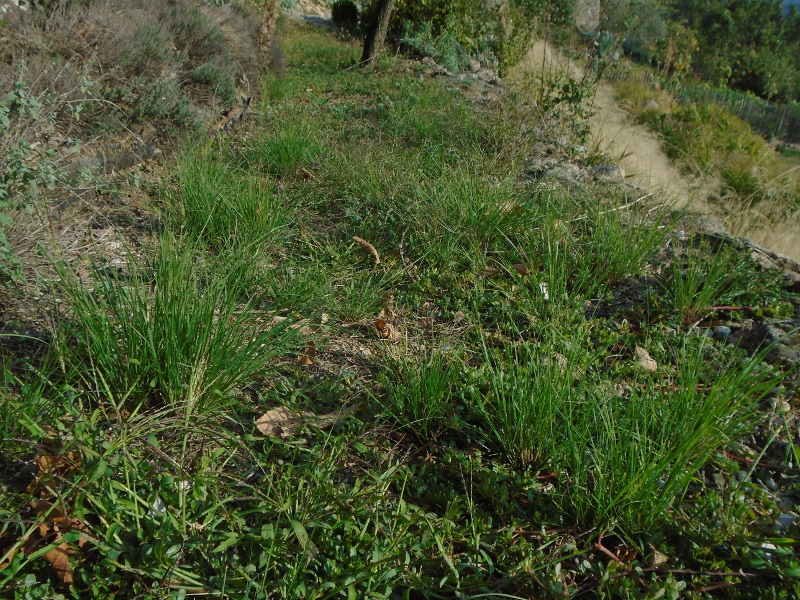Creating a drought tolerant lawn
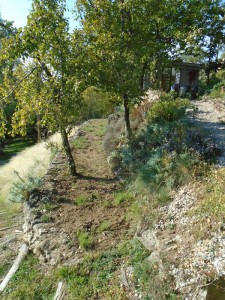 Sometimes it’s a good idea to take time over a project. I have saved myself from making a huge garden design mistake.
Sometimes it’s a good idea to take time over a project. I have saved myself from making a huge garden design mistake.
I have spent a day and a half weeding Alice’s path. This is a long path (18 metres long a metre or two wide) that sits below the shade garden bank and lies at the top of the pool bank.
It’s not a madly trodden path, but I often use it to wheel my wheelbarrow along and then haul weeds up the step to the compost beyond the potting shed.
My friend Alice helped me to make it over eight years ago. We raked like mad to remove thousands of stones. And then once was all neat and level, I sowed grass seeds.
(I also planted a row of calamagrostis Karl Foerster grasses down one side, but that’s an experiment best forgotten.) 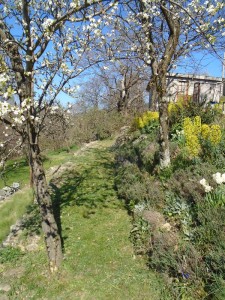
Some years. I think the first year. It was dandy. That was when the summer was cool and damp and everything lawn-like was lush and lovely.
I’m going to rummage in my records to show you how great it could be. The green gauge plums dropped all their fruit down one end. And the chestnut burrs littered the other.
But it has been a grassy path in slow decline ever since. And this drought stricken summer just about finished it off.
If you peer carefully you can even see that a lot of lovely proper drought tolerant eragrostis curvula seeds managed to germinate in the parched dying soil. I’ve never had such a crop before. I’m going to leave them in situ to grow on this winter, and then come spring I will uproot them and put them in a new home.
 I had some time to do a nice sitting down job these past two days, so out came the trowel and fork and Artur to supervise. He snoozes close by this path in the daytime – under the chestnut tree. And then in the late afternoon he likes to lie on the warm granite rocks that form one side of the path.
I had some time to do a nice sitting down job these past two days, so out came the trowel and fork and Artur to supervise. He snoozes close by this path in the daytime – under the chestnut tree. And then in the late afternoon he likes to lie on the warm granite rocks that form one side of the path.
I knew I had to weed out the unwanted annual mess that had made home in the parched soil. So I had to carefully work around the eragrostis. But once that was done – a day and a half’s toil – I raked well and assumed I would make good.
And by making good I just thought I would be wetting the soil, sprinkling liberal amounts of grass seed, watering well and watching a new grass path germinate.
A good winter’s cool and damp and come spring it would take off and I’d have my path again. 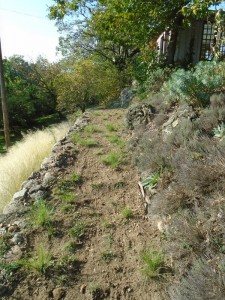
But what is the point of going to all that work and see the poor grass die off again in summer? Here’s the sad truth; there really is no such thing as a drought tolerant lawn. Not on this part of the garden anyway.
We keep our main lawn alive with a few sessions of watering in the worst of the heat. And there are a few underground springs near the edge of the lawn which help.
But this path is never going to be watered. The hose just doesn’t reach this far. And frankly, why would you bother? The potager gets water as I am growing crops, but a path?
So by the end of the day when I was back to dusty dirt and a few hardy grasses I have come to a decision.
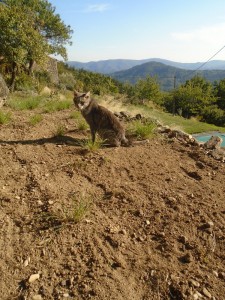 Mulch. I won’t bother to put any weed proof fabric down. That may stop a lot of the weeds, but all the wind borne grass seeds and weeds always make their way to the surface.
Mulch. I won’t bother to put any weed proof fabric down. That may stop a lot of the weeds, but all the wind borne grass seeds and weeds always make their way to the surface.
I could try gravel. But that would mean buying in a few cubic metres of the stuff because you have to pay for the delivery driver Didier to come and tip it at the top of the garden so one cubic metre won’t suffice.
And then you have to pay for Manu the Muscles to wheelbarrow it everywhere. And you are buying an extra cubic metre to fix all the paths in the potager that could do with a top up. And. And. And.
And it really doesn’t keep down the weeds. Not unless you lay a path so thick with gravel it would feel like you are trudging in deep sand. And remember, this is a path where a wheelbarrow has to travel.
An awful lot of Ands there. Sorry.
So I have decided to try for a few days of wood chipping to generate enough cover for this very long path. It is the best solution. My home grown mulch consists of sticks of chestnut from the farm and the forest, a few hundred oak branches and any sticks I see lying around.
It’s work. But apart from the use of the chipper and the electricity, I’m really just recycling.
For a while I toyed with the idea of digging up all the annual thyme plants that self sow merrily about the gravel on other paths. But I will never have enough thyme to cover the entire length. 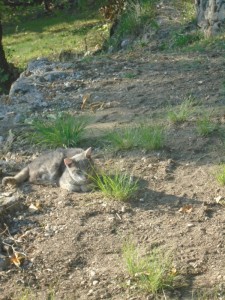
And another nifty side product of my home made mulch is that I improve the soil. You need a mix of dead wood and fresh to create a perfect environment to encourage fungus and good bacteria to improve things over the season.
And believe me, it was dry as dust here right now. Good for a cat to roll in. But there was nary a worm along the whole path. A thick mulch will retain moisture, will eventually break down and improve the soil and who knows, maybe in a few years time if I keep up the mulching I will have a new fun area to plant up with bulbs and lawn.
I’m excited already. The farm is going to resound to the din of the chipper as I reduce my mighty pile of sticks for a worthy cause. Photos to follow. You know you love the sight of yet more brown.
